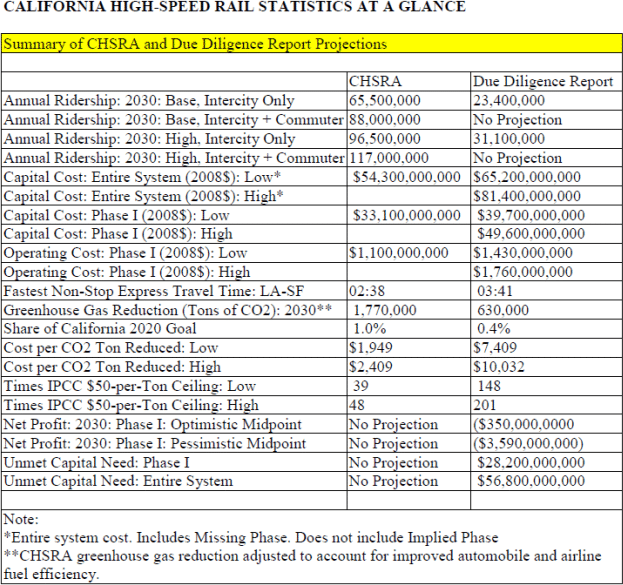Private Investment Impacts
- Investment losses are likely.
- Commercial bond default is likely.
Traveler Impacts
- Promised travel times are unlikely to be achieved.
- Trains will fail to meet the statutorily required maximum travel times.
- Airlines will continue to dominate the market between northern and southern California.
- Few travelers are likely to be attracted from cars in the shorter distance markets.
- San Diego and Sacramento extensions may not be built for decades, if ever, due to high costs.
Capital Costs
- Construction cost overruns are likely.
- Proposed state bonds will likely be insufficient to complete Phase I, Phase II or complete plan.
- Federal funding is likely to be far less than projected.
- Private funding is likely to be insufficient to finance the complete plan.
- Political “meddling” could increase capital costs.
- Additional state capital subsidies are likely to be required.
- Political “meddling” will require additional stations, more stops and slower train schedules.
- CHSRA’s capital cost projections for highway and aviation alternatives are implausibly high.
Operating Costs
- Operating costs are likely to be substantially higher than planned.
- Taxpayer subsidies to cover operating costs are likely.
Greenhouse Gas Impacts
- Impact on greenhouse gas emissions reduction to be small.
- GHG reduction to be far more costly than the international ceiling of $50 per ton.
Public Response
- Opposition may spread as site-specific urban, suburban and rural impacts become better known.
- Opposition by communities is likely to require reduced operating speeds and slower schedules.
- Mitigating unpopular neighborhood impacts could increase capital costs.
- Elevated tracks could create objectionable sound walls and other “Berlin Wall” structures.
Trains
- No train in the world meeting the operating specifications can be used legally in the U.S.
- It is unclear that any train redesigned to meet U.S. safety requirements can also meet the CHSRA speed and performance requirements.
- The train’s capacity is not set, which calls into question the accuracy of ridership, revenue and cost forecasts.
- Train weight is not set, which could affect speed, schedule, ridership, energy use and cost forecasts.
Road and Aviation Impacts
- HSR will fail to divert significant traffic from highways and airports.
- The Authority will fail to implement the bargain rail fares it currently proposes.
